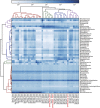Metagenomic covariation along densely sampled environmental gradients in the Red Sea
- PMID: 27420030
- PMCID: PMC5315489
- DOI: 10.1038/ismej.2016.99
Metagenomic covariation along densely sampled environmental gradients in the Red Sea
Abstract
Oceanic microbial diversity covaries with physicochemical parameters. Temperature, for example, explains approximately half of global variation in surface taxonomic abundance. It is unknown, however, whether covariation patterns hold over narrower parameter gradients and spatial scales, and extending to mesopelagic depths. We collected and sequenced 45 epipelagic and mesopelagic microbial metagenomes on a meridional transect through the eastern Red Sea. We asked which environmental parameters explain the most variation in relative abundances of taxonomic groups, gene ortholog groups, and pathways-at a spatial scale of <2000 km, along narrow but well-defined latitudinal and depth-dependent gradients. We also asked how microbes are adapted to gradients and extremes in irradiance, temperature, salinity, and nutrients, examining the responses of individual gene ortholog groups to these parameters. Functional and taxonomic metrics were equally well explained (75-79%) by environmental parameters. However, only functional and not taxonomic covariation patterns were conserved when comparing with an intruding water mass with different physicochemical properties. Temperature explained the most variation in each metric, followed by nitrate, chlorophyll, phosphate, and salinity. That nitrate explained more variation than phosphate suggested nitrogen limitation, consistent with low surface N:P ratios. Covariation of gene ortholog groups with environmental parameters revealed patterns of functional adaptation to the challenging Red Sea environment: high irradiance, temperature, salinity, and low nutrients. Nutrient-acquisition gene ortholog groups were anti-correlated with concentrations of their respective nutrient species, recapturing trends previously observed across much larger distances and environmental gradients. This dataset of metagenomic covariation along densely sampled environmental gradients includes online data exploration supplements, serving as a community resource for marine microbial ecology.
Conflict of interest statement
The authors declare no conflict of interest.
Figures






References
-
- Anderson MJ. (2001). A new method for non-parametric multivariate analysis of variance. Austral Ecol 26: 32–46.
-
- Anderson MJ, Gorley RN, Clarke KR. (2008) PERMANOVA+ for PRIMER: Guide to Software and Statistical Methods. PRIMER-E Ltd: Plymouth, UK.
-
- Barberán A, Fernández-Guerra A, Bohannan MBJ, Casamayor EO. (2012). Exploration of community traits as ecological markers in microbial metagenomes. Mol Ecol 21: 1909–1917. - PubMed
-
- Churchill JH, Bower AS, McCorkle DC, Abualnaja Y. (2014). The transport of nutrient-rich Indian ocean water through the Red Sea and into coastal reef systems. J Mar Res 72: 165–181.
MeSH terms
LinkOut - more resources
Full Text Sources
Other Literature Sources

